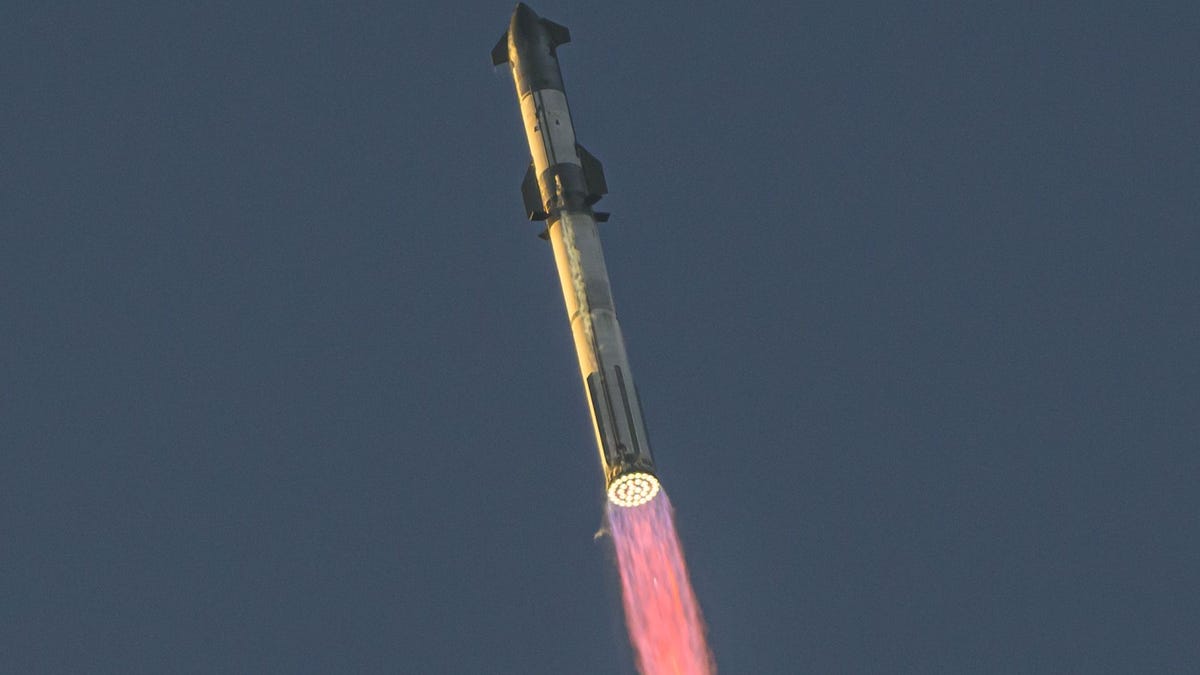
SpaceX’s latest test flight of the Starship rocket lasted for around eight minutes—twice the length of the previous test. Both the booster and the Starship upper stage were lost, but SpaceX achieved many key milestones during the flight test.
Starship has taken to the skies for a second time, and despite the booster exploding four minutes into the mission and the Starship upper stage doing the same several minutes later, the mission was a discernible improvement compared to the first.
SpaceX’s first attempt to implement a hot-staging technique prior to stage separation unfolded nicely, but the process mangled the booster (which is supposed to be reusable and eventually capable of performing vertical landings). And unlike the first mission, which failed prior to stage separation, the Starship upper stage managed to cut loose from the booster and fly independently for roughly four minutes before exploding over the Caribbean, and for reasons that aren’t yet clear.
The rocket left the Boca Chica launch mount at 8:03 a.m. ET on Saturday morning, with water blasting upwards to quell the power of 33 Raptor engines coming to life. The upgraded launch mount appeared to work as intended, with the booster not spewing as much dust and debris as was seen during the inaugural launch on April 20. This marked the second flight of Starship—the world’s most powerful rocket, albeit a rocket not yet certified for real-world missions.
Countdown preparations began at 6:00 a.m. ET, with SpaceX’s flight director performing a poll and verifying “go” for propellant load, The rocket’s fuel is a blend of liquid methane and liquid oxygen. At T-minus 10 minutes, the Starship’s 39 Raptor engines, including 33 on the Super Heavy first stage and six on the upper-stage spacecraft, underwent chilling ahead of ignition.
Encouragingly, all 33 Raptor engines on the booster appeared to stay lit during the mission (several engines either failed to light or shut down during the first launch). Two minutes and 41 seconds after liftoff, the hot-staging sequence—a process in which the upper stage’s engines ignite just before stage separation—unfolded as planned, with the booster falling away from the upper stage. Cheers from the SpaceX team could be heard through the company’s broadcast as this unfolded, highlighting the importance of this phase in the test mission.
Moments later, however, the booster exploded, in what SpaceX described as an “rapid unscheduled disassembly.” SpaceX said there was a chance the booster would not survive given the tremendous “load on top of the booster,” and that data from this mission will be used to improve the process and the rocket’s hardware. The booster, after performing its flip maneuver, was supposed to initiate a boostback burn and return to Earth, performing a splash down in the Gulf of Mexico. Hot-staging is done to reduce the time and complexity between the firing of rocket stages, allowing for a more seamless transition and increased efficiency during launch.
SpaceX said the key objective of the second test was to evaluate the ascent stage, and that everything that might happen after would be a bonus.
The booster obliterated, the upper stage Starship continued along its journey, but it failed just prior to SECO, or Second Engine Cut Off. SpaceX says its automated flight termination system triggered late in the Starship burn, but the reason is not yet clear. Starship flew for roughly eight-and-half-minutes before controllers lost the signal, when the upper stage was around 92 miles (148 kilometers) above the surface. The plan was for Starship to travel all the way around the globe and perform a hard landing in the Pacific ocean near Hawaii, with the total length of mission being 90 minutes.
Not a picture-perfect mission, but this test serves as a reminder of the complexities inherent in rocket engineering, particularly for a vehicle like Starship, which is designed to be the most powerful and versatile launch system ever created. SpaceX’s vision for Starship includes launching cargo and crew to Earth orbit, the Moon, Mars, and potentially other destinations, with the goal of making space travel more affordable through rapid reusability.
Failures are not uncommon in the arena of space exploration, in which risks and challenges are part of the journey. NASA, having contracted SpaceX to use Starship’s upper stage as a human landing system for the Artemis program, will be closely examining the outcomes of this test.
The focus now shifts to the analysis of this test’s data, which will be crucial for diagnosing the failures and guiding the necessary modifications. SpaceX’s iterative approach to design and testing is expected to play a key role. The company will likely schedule a third test flight, with parameters to be determined after a thorough review of this mission’s results. The next step is to nail stage separation, but other future milestones include a launch to orbit, reentry from orbit, and vertical landings of both the booster and the upper stage.
This is a breaking story with ongoing developments, so check back for updates.
Want to know more about Elon Musk’s space venture? Check out our full coverage of SpaceX’s Starship megarocket and the SpaceX Starlink internet satellite megaconstellation. And for more spaceflight in your life, follow us on X and bookmark Gizmodo’s dedicated Spaceflight page.
Credit : Source Post






